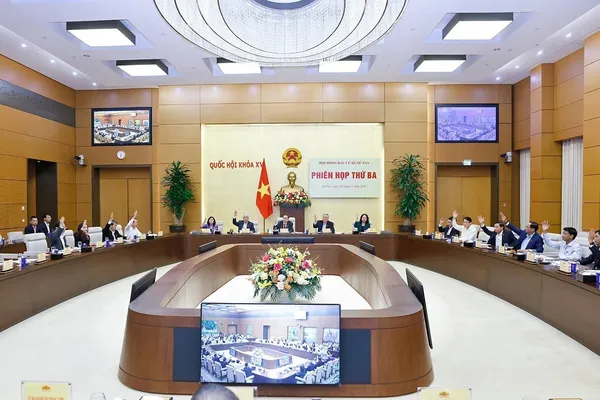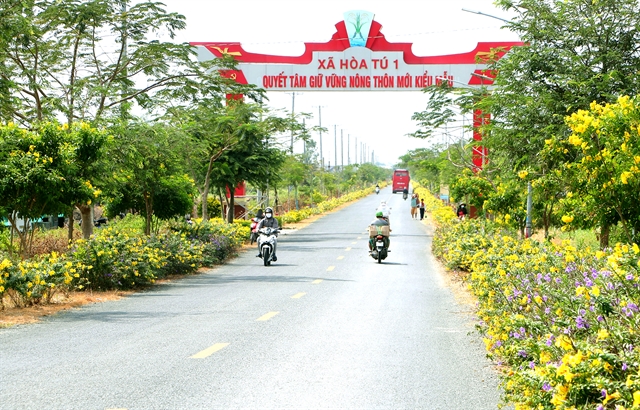 Society
Society

 |
| Local people travel on a road in Hòa Tú 1, the model new rural commune in Mỹ Xuyên District, in the Mekong Delta province of Sóc Trăng. — VNA/VNS Photo Tuấn Phi |
HÀ NỘI — Despite nationwide progress in poverty alleviation and rural development, results remain limited in some disadvantaged areas, with some impoverished areas yet to have a single commune meeting new-style rural criteria.
Minister of Agriculture and Environment Đỗ Đức Duy said that in the past four years, there have been marked improvements in living standards across the country.
Rural infrastructure has developed in a more synchronised manner, essential services have been expanded, poverty rates have declined rapidly and there have been positive shifts in both economic and labour structures, helping to narrow the gap between regions.
Nevertheless, the quality of new-style rural communes, model rural areas and poverty reduction models in some localities remains unsustainable.
Post-certification monitoring and quality control of OCOP (One Commune - One Product) goods have been neglected.
In remote and isolated regions, essential infrastructure and basic services are still lacking, and commune-level officials are often overburdened with multiple roles, with limited management and supervisory capacity.
Talking about the implementation of the National Target Programme on New-Style Rural Development during the 2021–25 period, Duy said that the programme has been guided by the principle that 'agriculture is the backbone of the economy', with farmers at the centre, agriculture as the driving force, and rural areas as the foundation.
As a result, the programme has achieved and in some areas surpassed its 2025 targets.
Specifically, 79.3 per cent of communes have met new-style rural criteria, nearing the 80 per cent target (up 10.6 per cent from the end of 2021); 42.4 per cent of communes have achieved advanced new-style rural status (exceeding the 40 per cent target); and 12.3 per cent have reached model rural commune status (surpassing the 10 per cent target and increasing more than seventeenfold compared to 2021).
As for the Sustainable Poverty Reduction Programme, Duy said by the end of last year, the national poverty rate had dropped to 1.93 per cent, a decrease of 3.27 per cent since late 2022. Some 35.2 per cent of especially difficult communes in coastal, island, and tidal-flat areas had escaped hardship, well beyond the 30 per cent target.
There has also been progress in child health, with stunting among children under 16 reduced to 25.4 per cent, significantly lower than the 34 per cent target.
Strategic directions
As the lead agency for both the national target programmes on new-style rural development and sustainable poverty reduction in the next phase, Duy said the overarching aim of the two programmes is to ensure inclusive and sustainable development, placing people at the heart of the process.
This must go hand-in-hand with modernising rural areas, aligned with industrialisation, urbanisation and a shift towards a green and circular economy, he said.
“We must promote scientific and technological innovation, digital transformation and closely integrate socioeconomic development with national defence, security, environmental protection and climate adaptation, particularly in vulnerable areas,” he said.
To ensure effective implementation, Duy proposed that the National Assembly prioritise funding for the 2026–30 and 2031–35 phases of the programme to achieve set targets.
He also recommended that the Prime Minister assign the ministry to coordinate with other relevant ministries in drafting the investment proposal for a unified National Target Programme on New-Style Rural Development and Sustainable Poverty Reduction for 2026–30.
The proposal would be submitted to the Government and then presented to the National Assembly during its 10th sitting.
The ministry would also take the lead in developing national criteria for rural development at all levels, delegating specific targets to local authorities.
Provinces have been urged to stabilise their rural development and poverty reduction task forces, restructure local steering committees in accordance with the two-tier administrative model, and accelerate the disbursement of public funds, especially centrally allocated budget resources.
From a local perspective, Vĩnh Phúc Province’s Party Secretary Đặng Xuân Phong called on the Ministry of Finance to submit a proposal to the Prime Minister for replacing Decree No 57/2018/NĐ-CP, which governs incentives for enterprises investing in agriculture and rural areas.
He also proposed expanding access to concessional loans from the Việt Nam Bank for Social Policies, enabling poor households to participate in national target programmes with interest rates adjusted to suit different periods.
Chairman of the People’s Committee of Quảng Ngãi Province Nguyễn Hoàng Giang also urged the Prime Minister to issue the 2026–30 rural development criteria promptly, ensuring they are tailored to real-world conditions and differentiated by region of mountains, plains or coastal areas so as not to place excessive pressure on disadvantaged communes.
He further recommended that the ministry issue guidelines for reviewing and evaluating whether newly merged communes meet new-style or advanced rural status.
Long An Province’s leaders proposed that the Government be urged to standardise the organisational structure of the steering committees responsible for implementing national target programmes to ensure consistency, leadership and operational efficiency.
The ministry has set ambitious targets for 2030, such as the average income of rural residents is to increase by at least 2.5 times compared to 2020, and no households should remain poor under the 2022–25 multidimensional poverty standards. By 2045, average rural incomes are expected to be at least 1.6 times higher than in 2030, and the national multidimensional poverty rate is expected to fall below 1 per cent. — VNS




